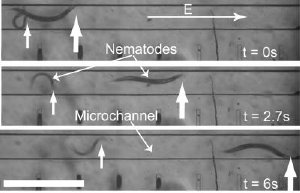Jan 5 2010
A Nobel-winning process for testing new drugs to treat diseases such as Huntington's, Parkinson's, and muscular dystrophy is getting an electrical charge.
 (a) The application of +8 V cm-1 electric field (E) caused an animal (724 µm long) to move with the speed of 308 µm s-1 to the right towards the cathode. (b) At a lower field strength in a reverse direction (-3 V cm-1) the animal (847.5 µm long) moved with a speed of 342 µm s-1 to the left towards the cathode. Dark thick arrows illustrate the worm's position. Scale bars are 1 mm. Credit: McMaster University
(a) The application of +8 V cm-1 electric field (E) caused an animal (724 µm long) to move with the speed of 308 µm s-1 to the right towards the cathode. (b) At a lower field strength in a reverse direction (-3 V cm-1) the animal (847.5 µm long) moved with a speed of 342 µm s-1 to the left towards the cathode. Dark thick arrows illustrate the worm's position. Scale bars are 1 mm. Credit: McMaster University
Researchers at McMaster University have developed a way to propel and direct microscopic-sized worms (C. elegans nematodes) along a narrow channel using a mild electric field. The discovery opens up significant possibilities for developing high-throughput micro-screening devices for drug discovery and other applications.
"This is the first time that worms have been stimulated to move in a micro-channel device in a very precise and directed way," said Bhagwati Gupta, assistant professor of biology. "It will allow researchers to study in real time how a proposed drug affects neurons and muscles that control motion of a live specimen."
The research is described in the January 21, 2010 issue of Lab on a Chip, a leading international journal in the field of nanotechnology and bioengineering. The researchers demonstrate movement of the worms forward and in reverse inside a microchannel, guided by the direction of the electric field (electrotaxis).
"The electrotaxis of the worms has the potential to automate what is currently a slow, manual process for drug screening on worms," said Ravi Selvaganapathy, assistant professor of mechanical engineering. "The system is fairly easy and inexpensive to scale up to conduct rapid screening of tens of thousands of chemicals in worms to identify drug candidates in a cost-effective manner. Such discovery could accelerate clinical trials in people by allowing scientists to focus only on relevant drugs and would use limited resources more efficiently."
Currently, researchers observe worms individually under a microscope as they move in a random manner or in a direction forced by pressure. The new development retains a worm's natural motion and causes no harm to the worm.
A surprising observation was that the response of the worms was dependent on its age and neuronal development. This allows for large numbers of worms to be sorted and handled in an automated manner.
The findings promise to impact other research areas as well. It will allow researchers to study how neurons respond to electricity. It can also be used to fabricate new kinds of devices to handle and manipulate large numbers of worms.
The use of C. elegans as a genetic model organism was first undertaken by Sydney Brenner in 1974. He was presented with the Nobel Prize in Physiology or Medicine in 2002 for his work in this area. Researchers working with C. elegans were also awarded Nobel prizes in 2006 and 2008.
C. elegans is a proven animal model for the study of human diseases because it utilizes many of the same proteins and molecules as humans. It also has a generation time of approximately only four days and a lifespan of about two to three weeks. This accelerates the understanding of the function of disease-related proteins.